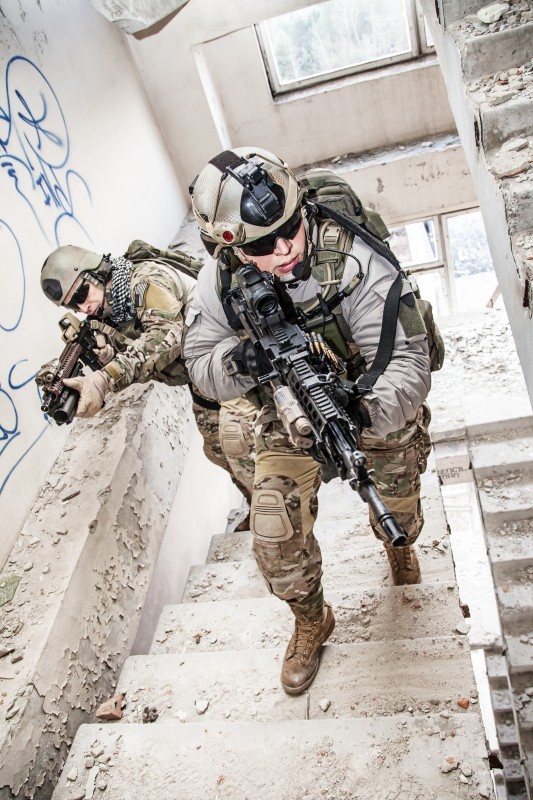
For those of you that may not be familiar with the Army’s testing for physical readiness, or the Army Physical Fitness Test (APFT), those of us who have served and have an understanding of physical fitness have been waiting for a day like this to appear for a while. The new Army Combat Readiness Test, which is set to start rolling out over the next few years, is designed with the hope of better assessing soldiers on their mission readiness through tests that are closer to real-world scenarios. Maybe this is coming from a place of bias and resentment, because at a lean 205 pounds, I was always the fat guy because my two-mile time was over 14 minutes…but I digress.
Before we get into my analysis of the new test, and how unit chain of command can implement training in order to not only excel on this test, but also excel as a fighting force, let’s delve into what the test is, and the changes that were made from the original APFT.
The original APFT is made up of three events. Those events are: max push-ups in two minutes, max sit-ups in two minutes, and then a two-mile run as fast as possible. From a logistics standpoint, these events make a lot of sense as they only take a small piece of land, a track, and one soldier to grade while the other performs the test.
RECENT: It's Meet Day — Do You Shine or Crumble?
The idea behind these tests is to test upper body strength, core strength, and endurance. These are all good attributes, but they neglect a lot of aspects of combat readiness that are extremely important to the task at hand. The battlefield has changed, and so should the physical fitness standards.
The new Army Combat Readiness Test was developed with that in mind. Instead of three events, now it is divided into six events. Those events are the following:
- Trap bar deadlift: Soldiers will be expected to perform a max trap bar deadlift between 120-420 pounds, receiving 3 attempts. Powerlifting, anyone?
- Standing power throw: Soldiers will be asked to do an overhead backward throw with a 10-pound ball for a max distance.
- T-Push-up: Much like your average push-up, except this doesn’t let soldiers cheat (or the graders be lazy). At the bottom position of the push-up, soldiers will have to pick their hands up off of the ground and push them out to the side before initiating another push-up.
- Sprint/drag/carry: On a 25-meter course, soldiers will sprint, drag a sled back, sprint, farmer’s carry two kettlebells back, and then sprint back to complete the course.
- Leg tuck: From a hanging position, soldiers will bring their knees to their elbows as many times as they can.
- Two-mile run: Staying in line with the APFT, soldiers will finish off the day with a two-mile run for time.
Personally, I think these tests are a better overall assessment of combat readiness, but they are not without their downfalls. The biggest issue that I see when it comes to these tests is the difficulty that they will create logistically; equipment set-up and space may become an issue unless there are dedicated spaces devoted to the test at the on-post gyms.
Another issue that I see arising is the dogma of the Army past pushing back against new training ideas. I can’t speak for everybody, but in my own experience in the military, senior enlisted and commissioned personnel seem to be stuck in the past with “calisthenics”, running, push-ups, and sit-ups. They’ve been the gold standard for so many years, that shifting gears may initiate some pushback. It’s like telling a high school football coach that maybe benching, squatting, and deadlifting to a max three times a week, and then running your team into the ground every practice, isn’t a good idea. It’s what they did when they played, so why should it be any different now?
Another issue I see is platoon and squad leaders who are not qualified or proficient enough with lifts (like a deadlift) trying to train their soldiers. The development of these tests was premised on the idea of lowering training-related injuries, but if leaders aren’t capable of teaching a proper trap bar deadlift, or triple extension in the throw, then I think we’re in for an increase in overall training injuries – unless there is some sort of direct physical fitness proficiency testing in leadership schools like BLC, BNOC, and ANOC. SFC Anthony Fuhrman, an active duty infantry soldier and professional strongman, said, “The first thing they need to do is look internally to all the amazing soldiers that have a solid knowledge of strength and conditioning. One failure that units are predisposed to doing is applying institutional training instead of looking internally and utilizing the vast amounts of talent to be found within the organization.”
I’m hoping that tests like the T-Push-up and the leg raises will help appease some of the older, crustier NCO’s that may push back on the idea, and while I don’t see an issue with them, I don’t see much of a benefit either. A static abdominal test (like a plank) would be a much better indicator of core strength and injury susceptibility. Also, I think a bench press relative to body weight would be a better indicator for overall upper body strength and endurance, but again, logistically, I can see why that might be an issue.
What I do like about these tests is that they are geared more toward real-world scenarios. CW3 Garrett Burns, who works as a senior instructor in Fort Sill, Oklahoma said, “The Army is a lethal, adaptive, and physically able fighting force. The traditional styles of counterinsurgency operations that soldiers are used to fighting in are all but forgotten in future combat environments. The enemy has evolved, and so must the Army. With that, the Army must prepare their soldiers now for the fight they will face tomorrow. Using legacy tactics for training and assessment such as the APFT and Physical Readiness Training (PRT) does not prepare current and future soldiers for the enemy and environment they will face; the AFCT definitely gets after those areas.”
MORE: Fighting 1000 lbs. in Kandahar
Absolute strength has been a long-neglected aspect of assessing combat readiness. As a medic, one of the things that I was tasked with was to teach other soldiers combat, life-saving techniques. A large portion of those classes was based on carrying the wounded out of danger, and how the wounded becomes a force-divider. One wounded soldier can theoretically make 3-4 soldiers combat-ineffective if they have to move said soldier. I don’t care how fast your two-mile run is, if you can’t carry me or another soldier with full gear off of the battlefield, in my eyes, that’s a liability. Having stronger soldiers can make our combat effectiveness much higher.
Having said that, I do like that the two-mile run has been kept in the testing. Many soldiers – myself included – have always lamented the two-mile run, especially those of us that are closer to the “meathead end” of the spectrum. While I agree that a two-mile run doesn’t directly translate to most real-world scenarios since the terrain and equipment has changed, for the most part, a strong cardiovascular base indirectly sets soldiers up to be stronger and recover quicker from grueling tasks.
Overall, I am happy to see that the Army is starting to take a more scientific approach to physical fitness. In the net series of this article, we will look more at how squad and platoon leaders can approach training for these events with their soldiers so they can set their units up for success.
Image credit: zabelin © 123rf.com












. The push ups are never graded properly and sit ups are useless. The bike was introduced for deployed ships with limited space and are now used by everyone now. I don't care for the 1.5 mile run, I like the USMC's 800 meter sprint in the first part of their test. Trap Bar deadlifts would be great! To pass the fat ass Sailors I serve with would need to actually go to the gym and practice the movement and hopefully continue to get better.
The biggest problem with Military fitness is that to get larger numbers of service members body fat requirements have been allowed to climb to up to 26 percent in the Navy and the requirements made easier.You don't have to be a ripped beast in the military but you should be able to act and look the part.
I apologize if this sounds too negative, Being a Command Fitness Leader up until a year ago I see things going down hill.
I'd change the sprint/drag/carry to a 186 pound sandbag (one of Ironmind's standard sand bags) 20 yards one direction, turn and run 20 yards back in 12 seconds or less. This would be the closest thing to mimicking carrying a wounded soldier. Something like that besides getting too fancy with multiple movements and pieces of equipment.
Thanks for posting this!
Command will also be disappointed to see that the "fat" soldiers perform better at the new test because they actually have muscle. No more of the 6'1" 175lb gazelles smoking the PT test.
Also, how are the weekend warrior reservists going to meet this standard?
The Army definitely isn't standing by the KISS principle on this one.
The gazelles will still smoke this test. Just about anybody can get to deadlifting 400 in no time, being HYOOOGE won't really be an advantage there. Or in any other event.